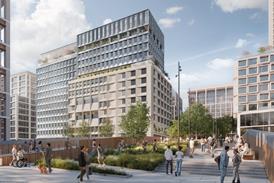Julia Park explains how to engage with the sprawling public examination process - so you can influence the shape of London without giving up your day job

Writing about a forthcoming London Society event, its chairman Peter Murray remarked that a representative of a leading housing association had recently said development in London was becoming “just too difficult”.
He, or she, went on to explain that high land values, the huge investment in fees before a project gets off the ground, the long delays in planning (a couple of years is not uncommon and complex sites can sit around for a decade), the uncertainty once the project gets to the planning committee and the possibility of it being called in, all add to the difficulties. On top of that, the mayor is committed to greater local consultation and has introduced tenant ballots for estate regeneration.
Essentially a debate about whether “faster is better” – between Daniel Moylan, co-chair of Urban Design London among other things, and Victoria Hills, chief executive of the Royal Town Planning Institute – next month’s report should be interesting.
Even for those of us committed to due process and democracy in the planning system, the current Examination in Public (EiP) of the Draft London Plan (DLP) is proving a trying process. Yes, it’s a full plan review, and rightly so; the current plan has been eked out since 2006. So it’s bound to take some time, particularly if you are committed to inviting anyone and everyone to express their view through a full, line-by-line, public consultation.
Part of the delay to what already felt like a very long process is that City Hall received 4,000 responses. Since then, it’s all been rather confusing and somewhat opaque.
The panel of EiP inspectors has held technical sessions on specific topics and selected some of the more controversial “matters” for the formal hearings which began in mid-January. In the run up, the panel prepared a set of questions pertaining to each matter and invited written responses by set deadlines most of which have now passed.
Anyone who had nothing more pressing to do than keep a constant eye on the EiP website and follow the tortuous process was free to submit a “written representation” addressing the questions relating to any or all of the matters. If you saw and responded in time to the invitation to participate in any of the hearings (whether or not you supplied written reps), you could bag a seat at the big horseshoe table in the chamber and have your say in public. If you’ve been invited, do remember to invert your name-plate when you want to speak and address the inspectors as “Sir”. It may be democratic but it’s also weirdly formal.
If the minutiae of the EiP proceedings haven’t been uppermost in your mind until now, you can still attend any, or all, of the remaining hearings, as long as you can manage to take the day off work, sit still and keep quiet for seven hours (the hearings are 9.30 - 17.30 with an hour off for lunch). Failing that, you can watch the live webcasts of the hearings or catch up with them later.
>> Also read: Architects hail London Plan as ‘beginning of a renaissance’
Judging by the list of participants, the entire process has been a bit much for the vast majority of architects; only a handful are due to attend. In reality, it’s only been open to those who knew where to look, found the time and energy to write or say something and are optimistic enough to think they might make a difference. The task is made more difficult by the fact that the GLA has already revised the draft plan to take account of the consultation responses (including a number from MHCLG) and continues to do so as the hearings progress. You have to be extremely vigilant to ensure that any written or oral statements take account of the latest version.
We managed to scramble together a few written reps and are hoping to get to a couple of the housing hearings. These began on February 5 with “Housing Requirement”, Matter M17. I watched part of it live on my laptop before guilt and a writing deadline got the better of me. The bit I saw soon strayed into housing mix, which is the subject of M28, scheduled as part of the March 1 hearing. This is likely to be one of the most controversial topics, mostly because the latest SHMA (Strategic Housing Market Assessment) suggests that 55% of new homes built every year between now and 2041 should be one-bedroom flats.
This appears to be because the GLA has finally got to grips with “concealed households”, aka “reluctant sharers”. In many ways this is welcome. The figures on HMOs have been fudged for too long and we’ve always been critical of that. But 55% is a whopping proportion and considerably higher than in the previous SHMA. On top of that, 78% of what is acknowledged to be a huge backlog needs to be available at social rents. Current policy, already seen as too difficult by many, requires 35% affordable housing of which only one third needs to be for the equivalent of social rent.
The concern that the new homes won’t be made available at the right price, is one of many. Most developers love the higher profit margins that accrue from one bed flats and studios, and won’t bother to build anything else, particularly as the draft plan warns boroughs not to dictate the mix for private housing. Instinctively, it feels like too much of one thing and contrary to the aims of mixed communities – particularly as small flats are the least flexible.
The evidence and methodology have also been criticised. The GLA’s approach to calculating housing need differs from the new (supposedly) standardised test in the NPPF. Evidence is based on previous patterns; in London’s case this amounts to inward migration of 20- to 29-year-olds and outward migration of 30- to 39-year-olds. It’s an established trend but there’s little evidence to suggest that cause and effect has been properly interrogated. How many 30-somethings leave London from choice and how many leave because having children, or wanting to, is the straw that breaks the camel’s back? London needs to attract and retain this demographic group, not drive it away.
Housing density and the green belt will be just as controversial. Perhaps this long and complicated process is just trying too hard? Brexit hasn’t been factored in because no one knows what will happen, and the new London Plan is likely to be delayed until early next year – just a few months before the next mayoral election. The outcome of either or both might force a re-think.
Looking around London today, it doesn’t feel as though getting planning permission should be easier. Despite the commitment to quality, numbers already seem to be the top priority. It was Nye Bevin who said: “We shall be judged for a year or two by the number of houses we build; we shall be judged in 10 years’ time by the type of houses we built.” He had a point.
Postscript
Julia Park is head of housing research at Levitt Bernstein
















4 Readers' comments